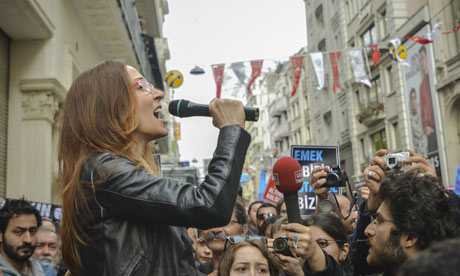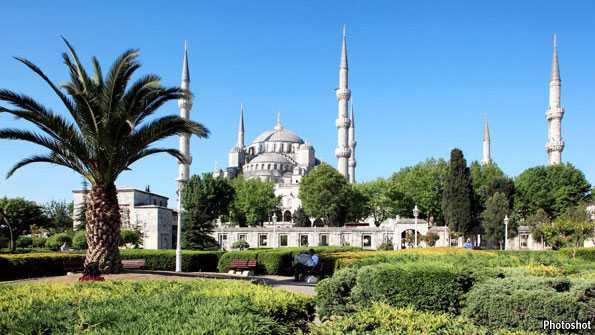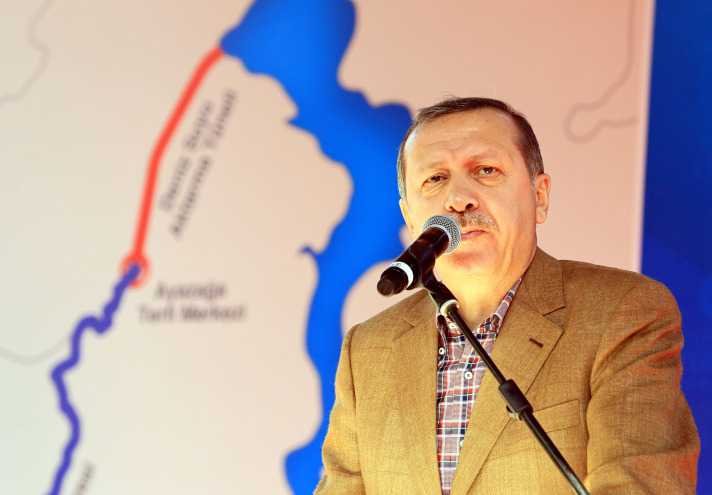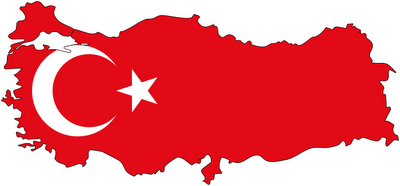Campaigners stage protest at plans to demolish historic venue to make way for a shopping and entertainment complex
Constanze Letsch Istanbul
guardian.co.uk, Monday 15 April 2013 21.00 BST

A woman makes a protest speech outside the former Emek cinema. Photograph: Karadeniz/Corbis
It is Turkey’s oldest and most prestigious cinema, an Istanbul landmark that dates back to the early days of Atatürk’s rule – and a centrepiece until recently of the city’s international film festival.
So plans to demolish the Emek theatre and turn the space into an entertainment and shopping venue have generated widespread disapproval – not least at the recent film festival, at which film directors, critics and residents came together in a passionate protest against the building project.
In 1924, the theatre opened its doors as part of the Cercle d’Orient complex, a listed art deco building designed in 1884 by Levantine architect Alexandre Vallaury. Despite massive public protest the building was leased to a private developer who plans to turn it into an entertainment and shopping complex. Demolition work started last week.
After a lengthy legal battle a local court approved the developer’s plans last December. The company announced plans to move the theatre to the fourth floor of the new building, but critics fear the Emek theatre will effectively be destroyed.
Azize Tan, director of the Istanbul film festival, thinks the demolition of the Emek theatre is a tragic mistake. “The theatre is a symbol for Turkish cinema that we need to protect,” she said. She said its closure in 2010 had had a negative impact on the festival. “Every big film festival has its flagship venue. The Emek theatre was ours for 28 years, and there is nothing to replace it with,” she said.
The closure of the cinema, which seats 875, also meant a substantial loss of capacity for the festival’s organisers. Since 1958, the cinema has been publicly owned and has provided the backdrop for small, courageous revolts: the first big public 1 May celebrations after the military coup of 1980 took place there, it housed leftwing concerts and did not shy away from screening Martin Scorsese’s The Last Temptation of Christ while religious groups protested outside.
“People in Istanbul have a very strong bond with the Emek theatre,” said Nil Kural, a journalist and member of the FIPRESCI jury of critics.
“We all discovered our love for films and cinema here.”
Many agree. Turkish film-maker Yüksel Aksu said the theatre had been the sole place of his cinematographic education. Addressing the Turkish government, he shouted: “If you cannot conserve this place, you will not call yourself a conservative. You will call yourself barbarian.”
The Emek theatre protests are a symbol for the right to decide over the fate of the city whose cultural and historical heritage is increasingly at stake. Many are critical of the unchecked urban development that is rapidly remaking Istanbul, and of ever-larger projects being forced on its residents without any public debate.
Only last week, the government approved a plan widely known as the “crazy project” to dig a canal parallel to the Bosphorus Straits. Meanwhile, whole historical neighbourhoods are being demolished to make room for profitable real estate ventures.
Last Sunday a peaceful demonstration against the demolition of the Emek theatre was dispersed with water cannons and teargas. Greek film director Costa-Gavras, who was among last week’s protesters, appealed in a letter to the Turkish prime minister, Recep Tayyip Erdogan, to save the theatre. “A prominent theatre, a cultural centre must not be destroyed. It’s like erasing a part of our memory and removing a significant place for the future. Therefore it would be a political, social and artistic failure,” he wrote.
Tan criticised the apparent lack of transparency. “Both the government and the developers refuse to reveal the entirety of the project. Nobody talks to us,” she said.
Nil Kural believes the discussion should not be based on profitability. “The Emek theatre is part of Istanbul’s cultural heritage and it should be preserved as such. Why should it have to be profitable? It needs to be supported. Would you close down a museum and turn it into a shopping centre if it doesn’t generate enough profit?” she said. She said she was still hopeful the theatre could be saved. “If the government intervenes now, we will be able to get our beloved Emek cinema back.”
via Turkey’s historic Emek theatre facing final curtain | World news | guardian.co.uk.



